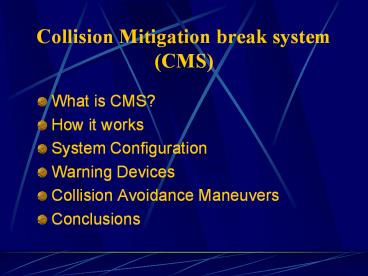Collision Mitigation break system (CMS) - PowerPoint PPT Presentation
1 / 15
Title:
Collision Mitigation break system (CMS)
Description:
Collision Mitigation break system (CMS) What is CMS? How it works System Configuration Warning Devices Collision Avoidance Maneuvers Conclusions References: Honda ... – PowerPoint PPT presentation
Number of Views:293
Avg rating:3.0/5.0
Title: Collision Mitigation break system (CMS)
1
Collision Mitigation break system (CMS)
- What is CMS?
- How it works
- System Configuration
- Warning Devices
- Collision Avoidance Maneuvers
- Conclusions
2
References
- Honda Motor Science Education. Trends in Japan
2003 - Autoweb.com.au Honda Develops New Collision
Avoidance Safety System. 2003 - Francois Granet, Rosella Picado, Lauren Smith
Longitudinal Avoidance. 2003
3
What is CMS?
- CMS is the world's first Collision Mitigation
Brake System (CMS). The technology predicts
rear-end collisions and assists brake operation
to reduce the impact. - CMS anticipates a collision based on driving
conditions, distance to the vehicle ahead and
relative speeds. It then uses visual and audio
warnings to prompt the driver to take
preventative action and also initiates braking if
the driver fails to respond to the warnings.
4
How it Works?
- First, the radar measures the distance between
the car and other vehicles up to 100 meters ahead
and any differences in speed, and an onboard
computer judges the risk of a collision based on
this information and on data about the course of
the car. - Then if the system judges that there is a risk of
a crash, such as when the car gets too close to
the vehicle in front, it alerts the driver by
sounding an alarm and lighting up a BRAKE
warning on the dashboard. This is the first
warning stage, aimed at alerting the driver to
the danger and encouraging the driver to slow
down.
5
- The system works in conjunction with the
"E-Pretensioner" seatbelt retraction system. If
the car continues to get closer to the other
vehicle and the computer decides that it will be
hard to avoid a collision, it tightens the
seatbelt more firmly and applies the brakes
forcibly and hard. - The CMS has three staged modes
- An audible warning,
- An audible warning, light braking and light
seat-belt retraction. - An audible warning, strong braking and strong
seat-belt retraction.
6
CMS configuration
- Millimeter-wave radar Detects vehicles within a
range of about 100 meters ahead, in a 16-degree
arc. - Sensors The system determines driving conditions
using a range of sensors that detect factors such
as yaw rate, steering angle, wheel speed, and
brake pressure. - CMS Electronic Control Unit (ECU) Based on
distance to the vehicle ahead and relative speed
obtained from radar information, the ECU
calculates the likelihood of a collision, and
warns the driver, and in some cases activates the
braking function.
7
- E-Pretensioner ECU Sends instructions to the
motorized E-Pretensioner to retract the seatbelt,
based on braking instruction signals from the CMS
ECU and electronically controlled brake assist
signals. - E-Pretensioner Retracts the seatbelt using an
internal motor, based on instructions from the
E-Pretensioner ECU. Used in combination with
conventional pretensioners. - Meter unit Receives signals from the CMS ECU,
and warns the driver of potential danger using a
buzzer and a visual warning.
8
(No Transcript)
9
Figure Autoweb.com.au, CAS 2003
10
CMS Warning Devices
- Visual head-up displays warnings are displayed
on the windshield in the driver's field of view. - Audio/Voice signals auditory signals appear to
be less intrusive on driving tasks.
11
CMS Collision Avoidance Maneuvers
- Headway distance control the system warns the
driver whenever his/her car is following the
leading car too closely - Hazard warning the system warns the driver of an
object within its projected path, so that the
driver has sufficient time to avoid a crash. - Automatic vehicle control the system controls
the vehicle's brakes and steering wheel
12
Precise breaks Actuator Systems depend a lot on
sensors
- Sensors fulfill the tasks of headway control and
obstacle detection, which are the basis of
Collision Avoidance Systems (CAS) Sensing.
13
(No Transcript)
14
Indicators
- Sensing range the maximum range over which the
technique can be used - Resolution the relative change in distance that
can be measured - Directionality the width of the beam over which
the sensor is sensitive - Response time how quickly the sensor can respond
to a change in distance
15
Conclusion
- Automatic braking systems can detect an obstacle
and bring the car to a complete halt just before
impact. The technology has reached the level
where the systems can even detect the speed of a
vehicle in front, compare it with the speed of
the user's car, and stop the car to avoid an
accident. Honda and Toyota are applying and
testing these Automatic braking systems nowadays
and will continue improving this type of
technology.































